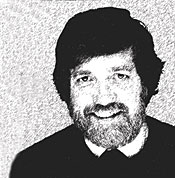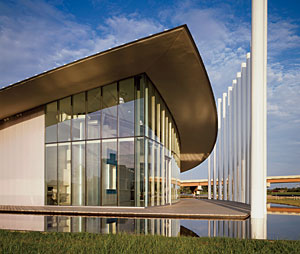David Dillon is the architecture critic of The Dallas Morning News.
 David Dillon | |
“Dallas is a very image-conscious place, and it has always been looking to headlines,” says David Dillon, who writes on architecture for The Dallas Morning News. Lately, the headlines have been filled with the starry names of the architects for the Dallas Arts District—an opera house by Norman Foster, a theater by Rem Koolhaas, and a science museum by Thom Mayne will soon join the existing sculpture museum by Renzo Piano and symphony hall by I.M. Pei. “It’s important to set the bar high, to have the chance to see good work built in your home city,” Dillon says.
Other design news from Dallas this year was the opening of the 33-story W Dallas Victory Hotel & Residences, designed by HKS, in the 93-acre Victory Park development downtown [RECORD, October 2007, page 146]. “The Victory tower is the best thing that has ever come out of that firm,” he says. “It’s a response to the growing sophistication of the market for urban architecture.”

Chesapeake Boathouse
The selection of Robert A.M. Stern to design the George W. Bush Presidential Library at Southern Methodist University does not surprise Dillon. “It was a foregone conclusion that there was not going to be any adventurous architecture—Gehry or Libeskind, no way,” he says. “It’s a conservative institution with a very conservative architectural culture. The list of firms considered was farcical—there was not a great deal of interest or expectation among Texas architects that they would want that job or even get that job.”
Dillon sees the continuance of a regional tradition in Texas, particularly in the work of Lake/Flato Architects in San Antonio and Max Levy Architects in Dallas. Lake/Flato is known for its embrace of sustainable design, reusing scrap materials in projects like the World Birding Center, from 2006. Max Levy is known for designing elegant, contemporary houses that rely on traditional formal responses to Texas weather. “Like [the late] O’Neil Ford in the 1950s and 1960s, people have a similar philosophy of wanting to design buildings that are appropriate and acknowledge the climatic conditions and materials of the place,” he says. “Lake and Flato, both of whom used to work for Ford, have carried on that sophisticated vernacular tradition and have jumped in scale, from houses to office buildings.”
“There is a maverick tradition in Oklahoma that goes back quite a ways,” Dillon notes, talking about Rand Elliott’s Chesapeake Boathouse in Oklahoma City [RECORD, May 2007, page 180]. He sees that project as a continuation of the tradition set forth by earlier architects like Bruce Goff. “There is a frontier attitude of, ‘We’re doing what we want to do whether or not anyone else cares,’ and there is no looking over your shoulder for what’s going on in New York.” Dillon says Elliott and architects like Antoine Predock in Albuquerque have cultivated clients and developed extraordinary work outside of architecture’s mainstream. “Elliott is a student of Oklahoma’s landscape, its sky, and Indian culture,” he says.
Echoing most critics, Dillon says affordable housing remains a challenge for architecture. “If you ever wanted a real laboratory for developing affordable housing and prototypes, New Orleans is it,” he says. “But what I’ve seen mostly is just a lot of New Urbanism stuff that doesn’t seem to get to the real problems of accessibility and affordability.” Dillon, in his teaching role at the University of Massachusetts at Amherst, studies affordable housing in the U.S. “It’s not a style exercise; it’s a community-building, economic exercise,” he says, explaining why high-design architects don’t pursue the arduous process of piecing together funding for such projects. “Dallas is 40,000 units short in terms of affordable housing, and the houses built by Habitat for Humanity and community development corporations don’t even begin to touch this need.”


